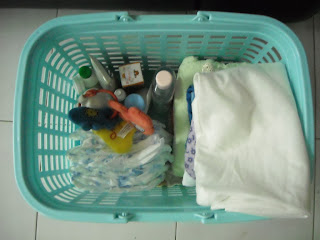| |
| Washing cloth diapers is so easy, you won`t believe it. Don`t let anyone tell you how gross and inconvenient it is. Read more about your options here... Many moms worry that cloth diapers will give them more things to do, and will take a lot of time and effort to wash, also they worry about stain and smell. That won`t be necessary. Here are the simple guide to wash your dirty diaper: |
| Storing dirty diaper: Wet pail VS Dry pail There are 2 basic methods for storing wet and soiled cloth diapers, the wet pail method and the dry pail method. In the wet pail method, all cloth diapers are placed in a pail filled with water. Storing the diapers in water (usually accompanied by baking soda) is said to help prevent stains from setting. When wash day comes, the water is drained in the bathtub or toilet and then the diapers go into the wash. This method has lost much of its popularity due to odor issues that arise from stagnant water, the potential for messiness, and the potential drowning hazard present by having a pail full of water in the vicinity of children. A wet pail can also be inconvenient when you consider that AIOs and diaper covers often need a separate (dry) pail. The dry pail method seems to be the preferred method, whereby wet and soiled diapers are merely placed within a covered (or uncovered) pail with no pre-soaking. Odors can easily be controlled by sprinkling baking soda on the diapers or putting a deodorant disc at the bottom of the pail. |
| Which Washing Method Works Best? We recommend that you wash no more than two dozen diapers at one time, too much friction can cause pilling. Because detergent build-up can occur we also recommend that you use less detergent than you normally would. Send your diapers through normal cycles like you wash your laundry in your washing machine.(no need pre-soak).Use a 1/4 cup of your preferred detergent.No fabric softener needed. It will cause build up in the fleece fabric. If you are experiencing odor problems, 2-3 drops of Tea Tree Oil or Dettol can help. And make sure you fasten all velcro tabs to avoid diaper chains. After the washing portion is finished, your diaper should smell fresh and clean with no hint of urines, feces, ammonia or other unpleasant odors. Every now and them you may need to do an extra rinse to help eliminate odors caused from a build-up of detergent. Once they are freshly cleaned they are ready to go in the dryer or be line dried. The heat from the dryer or the sun help to sanitize the diapers. Generally you should dry your diapers on hot for 60-90 minutes, with some AIOs or extra thick diapers taking longer. Make sure you check the washing and drying instructions for every brand of diaper you buy, to extend the overall life of your diapers. If your diapers do not smell clean to you – if you can still detect a lingering diaper odor – you should wash them again. The odor you’re smelling most likely means there is bacteria present in your diapers which could cause irritation to your baby and potential problems like diaper rash. If you want to cut your electricity usage by 50-60% then line drying is a good option. Not only do you help to conserve energy but the sun is wonderful for getting out tough stains on diapers. To avoid stiff diapers, set them out on the line during early morning or late afternoon hours when they will not dry as fast. Line drying your diapers will also extend their life, especially AIOs and covers. |
| Which Detergent Should I use? Generally you will need to use less detergent than normal for washing cloth diapers as they are easily susceptible to build-up. The detergent you use for washing your other clothing will usually work just fine for cloth diapers as well. There are some detergents that work especially well for cloth diapers though and fragrance free detergents are usually best for something so close to your babies skin. Don`t forget the amazing cleaning power of adding baking soda to your wash cycle and distilled white vinegar to your rinse cycle. Not only are they highly effective they are also cheap! |
| Should I Dunk in the Toilet? Many parents cringe at the thought of having to rinse soiled diapers before washing them. This is the reason why many would prefer to use disposables and "throw away" the problem. Dunking them in the toilet is not necessary however. In most cases, all that you need to do is lightly shake any excess feces into the toilet, perhaps using a bit of toilet paper to remove stubborn spots and then simply throw the diaper into your diaper pail. If you would feel more comfortable rinsing them, perhaps you could get a diaper sprayer that attaches to your commode or bathroom sink to lightly spray your diapers before putting them in the pail. Many cloth diaper retailers sell diaper sprayers or mini-showers as they are often called. The following products and processes are not recommended for use in laundering cloth diapers: |



 Whats in this bag?
Whats in this bag?










